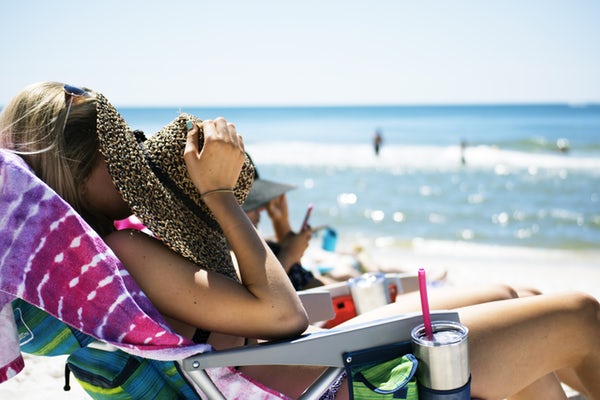Which SPF should I pick?
As you will learn, I care more about the active ingredients than the SPF. There’s so much more to the discussion than SPF, which only measures protection again UVB. What about UVA, HEV, and IR? Sound like alphabet soup? Read on.
SPF measures the length of time a product protects against skin reddening from UVB, compared to how long the skin takes to redden without protection. If it takes 20 minutes without protection to begin reddening, using an SPF 15 sunscreen theoretically prevents reddening 15 times longer – 300 minutes or about 5 hours. (Actually, it may take up to 24 hours after sun exposure for redness to become visible.) To maintain the SPF, reapply sunscreen every two hours and right after swimming.
The Skin Cancer Foundation recommends SPFs of at least 15, which blocks 93 percent of UVB. While SPFs higher than 30 block only 4 percent more UVB, they are advisable for sun-sensitive individuals, skin cancer patients, and people at high risk of developing skin cancer. They also allow some margin for error if too little sunscreen is applied. Considering that the SPF is developed using a whole ounce to the entire body, most everyone does not apply enough sunscreen and does not get the full SPF suggested on the label.
While SPF is the universal measurement of UVB protection, no comparable standard exists for UVA. Scientists worldwide are working to develop a standardized testing and certification method to measure UVA protection. Also, there is no effective measurement for protection against blue light HEV and Infrared that is now also known to be harmful.
What kind of light is the most harmful?
UVB (Ultraviolet-B) Short-wave solar rays of 290-320 nanometers. More potent than UVA in producing sunburn, these rays are considered the main cause of basal and squamous cell carcinomas as well as a significant cause of melanoma.
UVA (Ultraviolet -A) Long-wave solar rays of 320-400 nanometers. Although less likely than UVB to cause sunburn, UVA penetrates the skin more deeply, and is considered the chief culprit behind wrinkling, leathering, and other aspects of “photoaging.” The latest studies show that UVA not only exacerbates UVB’s carcinogenic effects but may directly induce some skin cancers, including melanomas.
The new issues to discuss include not just UV protection but also protection from HEV and Infrared rays. Increasing data suggests that these sources of light cause additional damage to the skin.
HEV? (High-energy visible (HEV) radiation) This radiation, also known as “blue light,” actually includes light from 400-500nm, and it can be just as harmful to skin, leading to inflammation, impaired healing, wrinkling, and discoloration. Most common sources of HEV include computers, television, phone, and iPad screens. Studies have shown that melanin (the pigment our body naturally makes) is the best protector against HEV in the skin. Many sunscreens are starting to incorporate melanin in them to block against HEV.
IR (Infrared radiation) Infrared radiation is what provides that warm sensation in the sun. According to the atlas of science “ The spectrum of solar radiation reaching the Earth is divided as follows: 6.8% UV, 38.9% visible, and 54.3% near infrared radiation (NIR). IR has been divided into three bands: IR-A (760–1400 nm), IR-B (1400–3000 nm), and IR-C (3000 nm – 1 mm). IR radiation can penetrate in and under the skin depending on the exact wavelength range being studied. Exposure to IR is perceived as heat.” There is still some scientific disagreement about the extent of the impact of infrared exposure on the skin. At this time, we can say that protection against IR is a plus. The new generation of ZO Skin Health sunscreens we carry is one of the few that protect against IR.
NEW TECHNOLOGY IN SUNSCREENS!
Photolyases! Photolyases work to correct DNA damage caused by sun exposure. Photolyases, DNA repair enzymes, occur naturally in the skin but are now available to apply topically. Products containing photolyases not only protect but ACTIVE REPAIR the skin as well. Antiaging products containing DNA repair enzymes have been available commercially for a few years in products such as ZO Daily Power Defense (plankton derived photolyases), but combining them with sunscreen at an affordable price point is new and exciting. We carry the only sunscreen containing photolyases in the Spring Boutique. It is made by ISDIN and is called Eryfotona Actinica. One study showed that in addition to protecting the skin, using a topical sunscreen containing photolyase could also decrease the number of active actinic keratoses. VERY EXCITING!
So the answer is…. I recommend an SPF>30. Make sure the bottle says that it protects against UVA and UVB, preferably 100% of UVA and UVB. Remember that sunscreens generally wear off or the chemical breaks down in 2 hours. So, sunscreen needs to be reapplied throughout the day.
I particularly like sunscreens containing zinc oxide and titanium dioxide. Zinc and titanium are physical barriers that work much better and last longer than the chemical sunscreens. Zinc has a more complete and broader coverage than Titanium. Throw in some protection against HEV and IR and some Photolyases for the ultimate sunscreen.
One final thing that my patients have grown to look for and love is my annual sunscreen picks. So, after a recent trip to Walmart, I am ready to go. Have trouble deciding which one to pick. Check out upcoming week’s blog post, where I will simplify things A LOT!
If you know someone who may find this article helpful, please share it with them! Follow us on social media this week, and subscribe to our growing YouTube channel!
If you would like to receive these posts in your email inbox, Subscribe to our Site!
